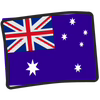about tea
where does tea come from?
Tea usually grows between the tropic of Cancer and the tropic of Capricorn, predominantly in warm, wet climates. The big players in the world of tea-growing are India, China, Sri Lanka and Kenya but this is by no means an exhaustive list: tea can be grown in any area with the right climate and conditions. There is even a tea-growing area in Cornwall - yes, Cornwall, England!
and herbal teas - where do they come from?
Very strictly and technically speaking, herbal "teas" are not really "teas" at all because they don't come from the tea bush (Camellia Sinensis), but herbal "infusions" but we're not very technical so either is just fine. There are hundreds of herbal infusion combinations and different herbs are grown all over the world. Click here to learn more.
what is rooibos or red tea?
Rooibos tea, often known as either redbush tea or just plain red tea, is not from the Camellia Sinensis bush, therefore is technically an herbal tea.
why does tea vary so much in taste?
Growing conditions, soil, climate and altitude all make a big difference to the quality of a tea. In addition the process that the leaves go through, and the skill of the people involved, will ultimately decide a tea's taste.
where do teapigs teas come from?
We buy our tea and herbal infusions from all around the world, including countries as diverse as Rwanda, Taiwan, China and India.
I have a corn allergy - does this mean I can't drink teapigs?
While the material for our tea temples is derived from corn starch, the intense process it goes through means that it’s highly unlikely any traces of corn is left within our products. However, we can't guarantee that all traces have been removed so recommend talking to your doctor about your allergy before you decide to drink teapigs. Alternatively take a look at our loose-leaf teas.
is tea a diurectic?
Any drink that contains caffeine (either naturally or added) is considered a diuretic, but the effect will depend on how much caffeine is consumed – a few cuppas shouldn’t have a diuretic effect, but lots throughout the day might, and it will vary from person to person.
why do your teas cost so much?
It's fair to say that our teas are more expensive than traditional "supermarket" teas. But it simply comes down to quality; the finest quality whole leaf teas cost more. How could we deliver the exquisite taste of the finest teas from around the world, with all the work that goes into producing it, for only pennies a cup?
what is the caffeine content of teas?
All teas from the Camelia Sinensis plant (so black, green, white and oolong teas) naturally contain caffeine in varying amounts, depending upon a number of factors - in particular, where it is grown and how it is brewed. Typically, the caffeine content of an average cup of tea will vary from between 30 – 75mg. Most, but not all, herbal teas are naturally caffeine free. You can discover our caffeine-free teas here.
how is the caffeine removed from your decaf english breakfast?
The tea leaves are wet, then have hot, pressurised CO₂ passed through them (yep, the same stuff you breathe out all day!). The caffeine & CO₂ molecules grab hold of each other and are whisked away, leaving the tea unharmed behind. It's then filtered out, and the CO₂ is separated back out ready to be used for the next batch. The now decaffeinated tea is dried and packed into temples - ready for you to enjoy any time of the day!
what are flavourings?
We know the word ‘flavourings’ can sound a little suspicious and scary, but never fear – no nasties are hiding in your tea! We use natural flavourings (like natural oils and extracts) in some of our teas to round out the flavour and ensure the end brew is just perfect. We only ever use the best quality, all-natural ingredients.
pregnancy and breastfeeding
We would suggest consulting your GP if you have any concerns about drinking teas or infusions during pregnancy or whilst breastfeeding.
how many cups of tea with liquorice root in can i drink a day?
You may have noticed we have a warning about avoiding excessive consumption on any of our teas that contain more than 10% liquorice root - but how many cups is excessive? Some studies on the effect of liquorice on the body suggest that it has the potential to increase blood pressure and decrease potassium levels. It is worth noting that the liquorice used in these studies is not liquorice in its natural form. The liquorice we use in our tea is natural liquorice root. To be on the safe side though, we recommend that anyone suffering with hypertension (high blood pressure) limits consumption of our liquorice & peppermint, fennel & liquorice and sweet ginger teas to one cup a day and be sure to follow any advice from your GP.
made in a factory that handles nuts
We have our tea produced in a factory which also produces teas for other brands. Some of the other blends they produce contain nuts. Whilst every precaution is taken to ensure there is no cross-contamination, we believe that we should make you aware of this. The nuts used are almonds and hazelnuts, so we can assure you the factory is a peanut-free zone.







